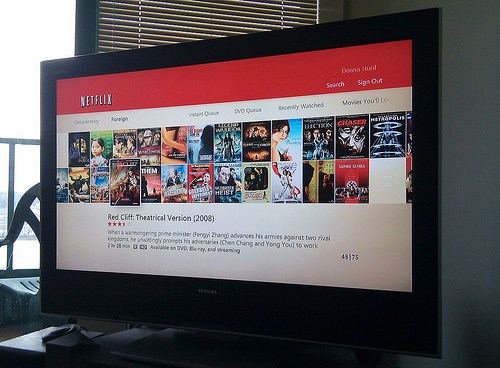By Karen Aney (The Cascade) – Email
Print Edition: November 30, 2011
It’s taken five long years – an incredibly long gestation period. After all that time, though, it’s finally happening. They found some money in the banana stand; they’ve conquered the BS. Arrested Development is back, having signed an exclusive production deal with Netflix. Now we just have to sit around until 2013, when it’s slated to be released. Or figure out how to fool our internet service providers into thinking we’re American.
Why? Well, a big concern for us canucks is that there are no publicized plans to release the show in Canada so far. The press release on the Netflix website states that “…Arrested Development will be coming exclusively to Netflix for its U.S. members to watch instantly, beginning in 2013.” While this statement does not necessarily preclude the eventuality of Canadians having the show made available to them, it implies that the show will only be available south of the border. This is possible—even unsurprising—because Netflix and Netflix Canada are two separate entities, experiencing different business models and services.
They have different movies and shows available, and the services come at a separate cost. Up until this summer, Netflix in the States came at a cost of $8 per month. This included all streaming capabilities, but also gave users access to the DVD subscription service. In a move that Netflix CEO Reed Hastings jokingly described as being “all the Canadians’ fault,” the company then split its services to Americans: the DVD subscription was called Qwikster and the streaming stuck with the name Netflix. The catch? After the services separated, they were charged separately. Each cost $8. Long story short, they were given half the service for the same cost.
The customer’s voice was heard, though. After more than 800,000 subscriber cancellations (a number published by the National Post), Netflix reversed its decision and abolished Qwikster. Since the fiasco, though, the stock of Netflix has been steadily decreasing from its high of $304.79 on July 13 to $63.75 last Saturday, November 26. Though the date of the Arrested Development press release, November 18, represented a slight rise, the stock has been steadily falling ever since. What’s more, Netflix can’t promise its investors anything different. In a statement they released, they stated as follows: “If we are unable to repair the damage to our brand and reverse negative subscriber growth, our business, results of operations, including cash flows, and financial condition will continue to be adversely affected”.
For my (non-existent) money, though, Netflix looks like a pretty good investment. Just compare it to the music industry after the advent of iTunes – a service that enabled users to listen to what they wanted, when they wanted it, from the comfort of their own homes. After the introduction of digital music into the American market, the music industry enjoyed a slight, one-year rise in sales. Since then, it’s been steadily declining. However, the sales that do happen are increasingly digital-focused (see included chart – also note that CDs take up the largest chunk of this chart, proving once and for all that humans like shiny things).
So what does this mean? CD players are being replaced by iPods; radios are being replaced by podcasts. Is regular old TV being replaced by Netflix? The cable TV model doesn’t serve the western world market very well anymore; while PVR has allowed its subscribers to pause and fast forward, the ease and on-demand nature of Netflix just isn’t there. Further, chief content officer of Netflix, Ted Sarandos, stated in The New York Times that the Netflix model offers a home for so-called smart comedies everywhere. When shows like Arrested Development aren’t successful on cable television, it’s hypothesized that the cause is the draw of other shows. For example, live events. Sarandos explained, “There’s nothing in our model that makes a show more valuable if it can attract a large audience at a specific time. As long as it happens in the life of the license, it’s fine by me.” And really, what type of show doesn’t benefit from that model? What, exactly, is cable TV good for anymore? News, sports, battles of the dancing idols?
The one thing that stands in the way of Netflix’s rise is money – greedy, greedy Hollywood. The original contracts that Netflix held with various studios are all slowly expiring, and they won’t be coming as cheap this time around. An analyst for Wedbush Securities, Michael Pachter, estimated that licensing costs for Netflix will rise from 2010’s $180 million to $1.98 billion in 2012. The rising prices make sense – they enable studios to keep a chunk of profits, especially if users will be turning to streaming content rather than going to a movie theatre or paying for cable. The fact remains, though, that streaming is coming at an increasingly hefty price tag.
I, for one, am glad that there’s currently a home for comedies like Arrested Development. It’s cerebral yet amusing and, most importantly, something I’m not embarrassed to admit that I watch (anyone else miss Hannah Montana?). Community, another recently axed show (technically on hiatus), is in much the same boat that Arrested was in a few years ago. My suggestion? Hop on the streaming bandwagon, Community, before it prices itself out of relevance. The world needs more quality TV, even if it’s not coming from a TV anymore.


